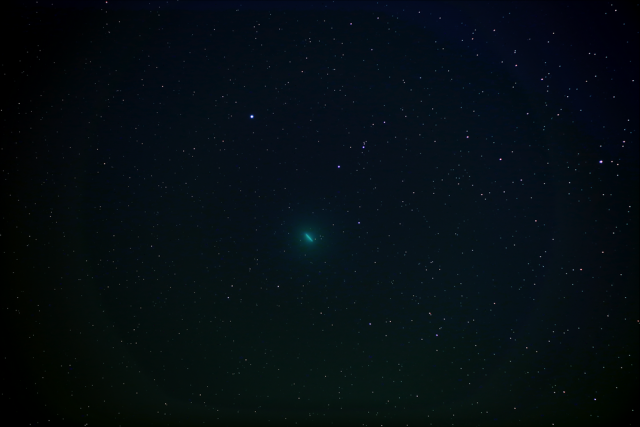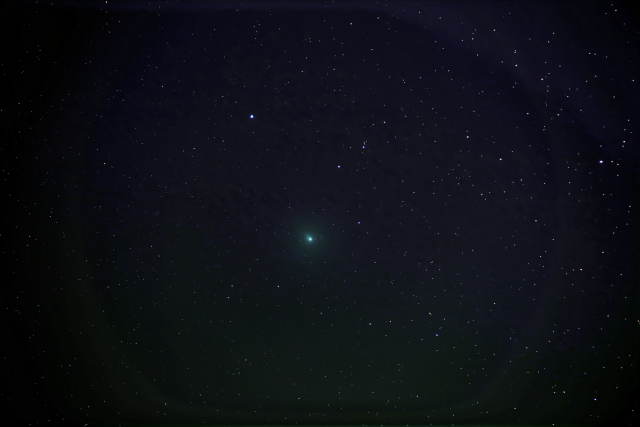- This topic has 7 replies, 4 voices, and was last updated 7 years ago by
Martin Cole.
-
AuthorPosts
-
5 December 2018 at 10:03 am #574196
 DawsonParticipant
DawsonParticipantThis comet is getting plenty of attention on the BAA Members Pages and elsewhere, and even I’ve had a go at imaging it. Processing the data s much harder though than for other things I’ve attempted to image. I’m on about the 9th round of processing in DSS at present.
What methods and software do others use to stack comet images? I’ve got lots of 30 second exposures using an IDAS LP filter; I did make the awful [and regular] mistake of shooting in JPEG and not RAW. Below is a single sub, not the stacked result.
James
Attachments:
5 December 2018 at 10:04 am #580322 DawsonParticipant
DawsonParticipantMore info…
Canon 6D with an IDAS LP filter, on WO Meg 72 FD with WO 0.8 focal reducer; lots of darks and flats too.
5 December 2018 at 4:29 pm #580324 DawsonParticipant
DawsonParticipantI think the fundamental issue with my data is:
– subs too short, I will try 60 second subs, but not guiding so will have to get the PoleMaster out
– I stupidly shot in JPEG and need ot shoot in RAW
– I think the comet will be better when higher in the sky.
Here is one of my many stacks, where I forgot to identify the comet as a comet and it’s just stacked on the stars!
James
 5 December 2018 at 7:29 pm #580325
5 December 2018 at 7:29 pm #580325 DawsonParticipant
DawsonParticipantGive up…
Will try again in 10 days when higher in the sky and I can take longer subs. Stack below from DSS trying to focus on the comet and the stars. FoV 5.93 degrees x 3.95 degrees; focal reducer flattener is designed for cropped sensors, not full frame sensors which is why I think there are still some obvious gradient rings from some vignetting despite making some flats.
Video of the comet moving over one hour also available here, but 200MB:
https://www.dropbox.com/s/gvtr6kk4mmoouio/IMG_7940_pipp.avi?dl=0James
 5 December 2018 at 7:52 pm #580326
5 December 2018 at 7:52 pm #580326 Martin MobberleyParticipant
Martin MobberleyParticipantHello James,
There’s no simple answer to the question of how to process comet images as every comet is different. Some move fast, some move slowly, some have very little tail detail and some have loads of complex ion tail detail. Also, individual equipment, and skies, and detectors vary considerably. My own recent 46P images have all been remote, via Siding Spring. The comet has been almost overhead there, in a very dark sky. In addition the system I’ve been using has a sensitive FLI 16803 cooled detector. I take LRGB images because the L image goes deep and produces a very smooth background, so the noise in the RGB images is not obvious. With the system you are using it would be best to take as many frames as possible to improve signal-to-noise. Even exposing for 1 hour (eg 60 x 60s) is not excessive providing you are happy with long star trails.
Modern CMOS (eg ZWO ASI) devices have sensitive low noise detectors which would outperform your Canon 6D. The Sony A7s cameras have remarkable sensitivity too. Your images look very dark. What’s needed is some sort of log stretch to brighten up the outer coma without burning out the comet’s core. A straight histogram stretch won’t work. All modern astro packages have a variety of stretches which can be experimented with for best results.
I used to use AIP4Win but now (as AIP V2 doesn’t like Windows 10) use AstroArt 6. Weeks of endless experiments with various stretching routines and tweaks will deliver the results. For final labelling and jpeg production I use an old copy of Paintshop Pro!
I could go on, but it’s an endless subject!
Some experts use k-sigma type routines to separately stack on the stars and stack on the comet resulting in an image with stars and comet stationary, but that is VERY complex and labour intensive. Some even image the stellar background separately when the comet has departed so the comet doesn’t mess up the starfield! Obviously at some point science drifts into art if you take that approach too far!!As a first step I’d simply stack as many short exposures as possible with the comet as high up as possible, in as dark a sky as possible, and then experiment with every non-linear stretch routine you have at your disposal to see which works best!
Email me direct, off-forum, if you want any detailed info!
Martin
6 December 2018 at 5:58 am #580327 DawsonParticipant
DawsonParticipantThanks Martin. This was 120 x 30seconds, so an hour in total. I’m going to wait until it is higher in the sky and try for 60 second subs, and maybe try without the LP filter. I think the LP filter is also cutting out a good proportion of the cometary photons.
I’ve got an ZWO 224 (colour) but it’s not cooled so I suspect it would be vastly more noisy than my Canon and not significantly more sensitive, but maybe worth trying that too, but I suspect 30 seconds on the ZWO would be VERY noisy.
Food for thought, thank you.
James
14 December 2018 at 12:27 pm #580397Hello James,
you can use pixinsight to process comets and asteroids.if you can track the comet and take some tracking the sky. I would use star align then stack proceeding to use the special comet tool. A4WIN is my preferance for doing the reductions as the script in Pixy is not user frindly.
Clear skies
Nick
14 December 2018 at 10:55 pm #580399Martin Cole
ParticipantVisible tonight in image stabilised 15×50 binos quite easily, though only the coma seen as a ghostly patch. Still that’s something from these light polluted parts…
-
AuthorPosts
- You must be logged in to reply to this topic.
